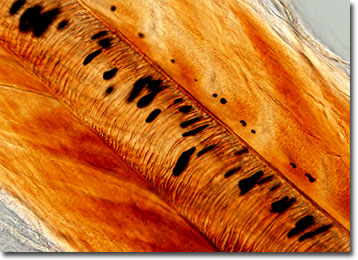Differential Interference Contrast Image Gallery
Lancelets (Amphioxus)
The amphioxus is a small eel-like creature that frequents coastal waters in warmer areas of the world. Although they sometimes achieve large numbers, humans do not often see them because they spend most of the daylight hours buried in sand or gravel on the ocean floor.

Amphioxi, which are also often referred to as lancelets, are invertebrates that were mistaken for slugs when they were first discovered in 1778 by Piotr S. Pallas. The misidentification is understandable since the marine animals have tapered forms without eyes or distinct heads. The creatures also do not have well developed brains or hearts and are not buoyant. They can swim side to side by contracting the staggered muscle blocks that line the flanks of their bodies, but whenever they cease to do so, they sink.
Since they are quite modest in size, usually reaching a length of about three inches, more than five thousand amphioxi may be present in a single square meter of sand. However, because they are extremely adept at filtering water through their gill slits, they are generally considered beneficial in areas where such significant populations exist. Some societies even harvest amphioxi commercially as a source of food.
